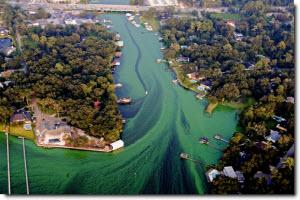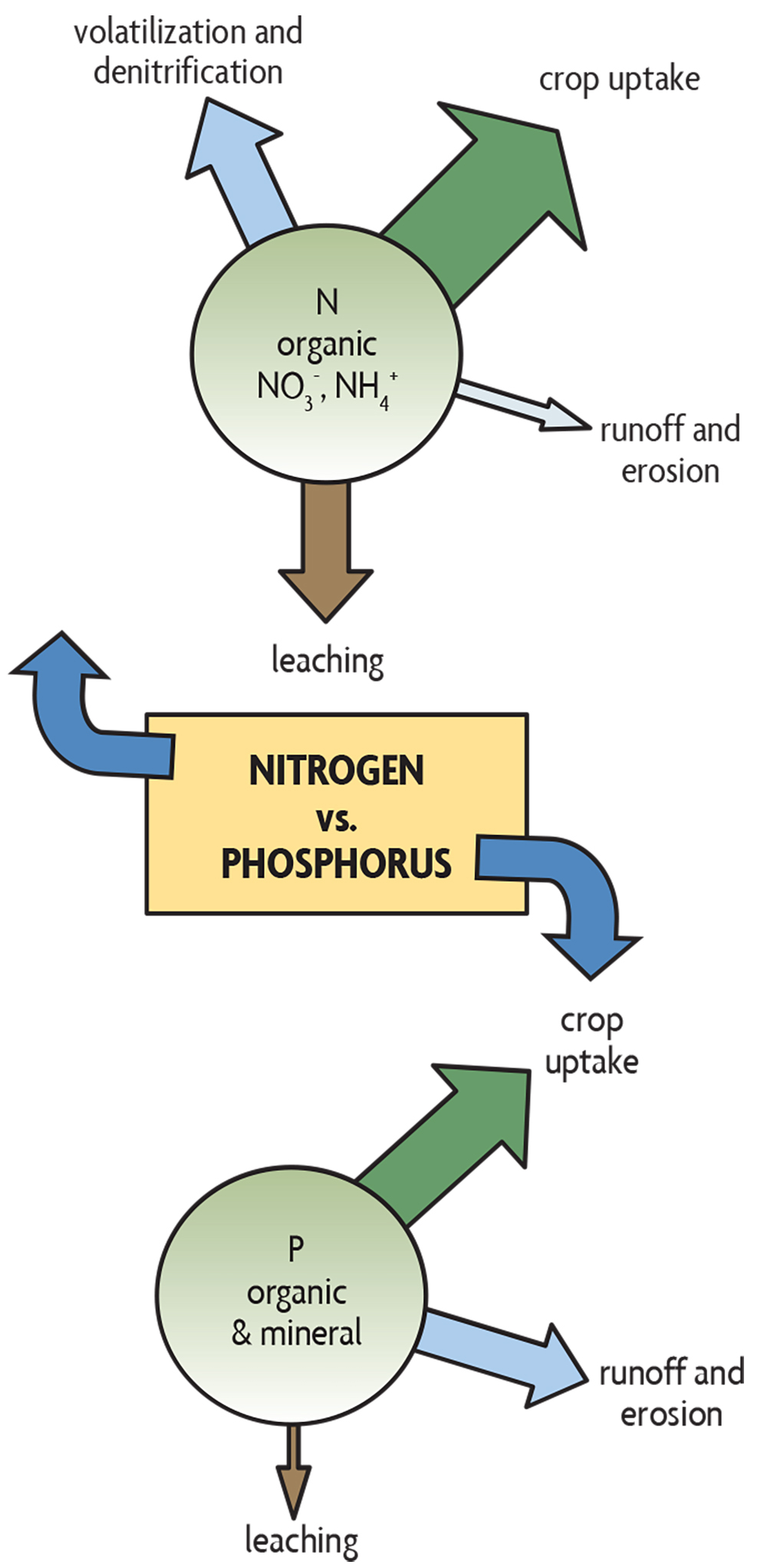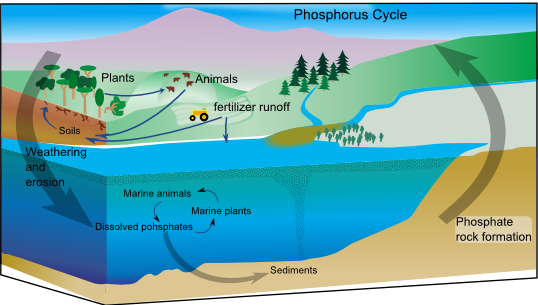Agree! Why Is Nitrogen And Phosphorus Bad For Water
Its great for food crops but its not great for aquatic systems because it enhances the growth of plants over the growth of other wildlifeeutrophication. Nutrient pollution is the process where too many nutrients mainly nitrogen and phosphorus are added to bodies of water and can act like fertilizer causing excessive growth of algae.

Rock Phosphate Fertilizer Garden Myths Nutrient Cycle Sulphur Cycle Plant Nutrients
Excess nutrients such as phosphorus and nitrogen exist naturally in aquatic systems but are detrimental if concentrations become elevated for several reasons.

Why is nitrogen and phosphorus bad for water. Answer - Excess phosphorus and potassium can be detrimental to the environment by moving in runoff water and posing a threat to water quality. When spread on the land it will not leach like nitrogen unless the soil matrix where phosphorus binds becomes overly saturated with phosphorus. Too much nitrogen and phosphorus in water could lead to an overgrowth of free-floating plants such as duckweed and filamentous algae.
However phosphorus will run off if applied at the wrong time of the year andor when soil erosion occurs. Phosphorus occurs in dissolved organic and inorganic forms or attached to sediment particles. The area affected currently stretches 5000 square miles but has been much larger in past decades.
Phosphorus is a nutrient that increases plant growth. Phosphorus like nitrogen is a critical nutrient required for all life. These overgrowths can result in dense layers of scum on the surface of the waters and can damage below-surface plants fish and other lake organisms by.
In the late 1960s scientists discovered phosphorus contributed by human activity to be a major cause of excessive algae growth and degraded lake water quality. Excessive nitrate can result in the restriction of oxygen transport in the bloodstream. Aquatic plants are limited by phosphate and the addition of phosphate will induce algal blooms eutrophication.
Nitrates and Phosphates. The Impact of Nitrogen and Phosphorus on Water Quality 2 As lakes and streams drain into other bodies of water the combined effects of nutrient loads from multiple streams can cause oxygen-depleted dead zones downstream. Nutrient pollution is the process where too many nutrients mainly nitrogen and phosphorus are added to bodies of water and can act like fertilizer causing excessive growth of algae.
Too much nitrogen and phosphorus in the water causes algae to grow faster than ecosystems can handle. Excess nitrogen in the atmosphere can produce pollutants such as ammonia and ozone which can impair our ability to breathe limit visibility and alter plant growth. The other nutrients of concern in water pollution are ammonia and phosphorus.
Too much phosphorus can create water quality problems. By Richard Conniff August 7 2017. Most commonly used nitrogen and phosphorus fertilisers are very soluble and are designed for average annual rainfall of less than 600mm or soils that can retain these nutrients.
Excess phosphorus causes algae to build up in waterways disrupting the ecological balance. The Effects on Water Quality. Phosphorus P is an essential nutrient for all life forms.
Too much nitrogen and. Information on Phosphorus Amounts Water Quality Introduction Phosphorus is one of the key elements necessary for growth of plants and animals. Under natural conditions phosphorus is typically scarce in water.
Click to see full answer. Why is nitrogen and phosphorus bad for water. Phosphorus plays a role in deoxyribonucleic acid DNA ribonucleic acid RNA.
Recent research has shown that when soils become saturated with water to the point that excess water runs off the site there is a potential risk that some soluble phosphorus can be. By Maureen A. In the high rainfall areas more than 600mm average annual rainfall especially on sandy soils these nutrients can be leached into the groundwater and.
Nutrient pollution also referred to as eutrophication is a widespread environmental and economic issue. Phosphate PO4 which plays major roles in the formation of DNA cellular energy and cell membranes and plant cell walls. Leaching of fertilisers can cause serious environmental and economic damage.
Excessive amounts of nutrients can lead to more serious problems such as low levels of oxygen dissolved in the water. The EPA has established a maximum contaminant level MCL of 10 mgL as nitrogen for nitrate in drinking water. Concerns about nitrate and total N in Minnesotas water resources have been increasing due to effects of nitrate on certain aquatic life and drinking water.
Two well-known dead zones exist. The findings underscore the urgency of reforming agriculture to dramatically reduce the use of nitrogen fertilizers. Significant increases in algae harm water quality food resources and habitats and decrease the oxygen that fish and other aquatic life need to survive.
In recent years in order to address the resultant excessive levels of these chemicals found in. Phosphorus is also present in manure. New research shows that increases in rainfall and extreme weather because of climate change will increase the amount of nitrogen polluting rivers and other waterways.
Excess nutrients including nitrogen and phosphorous combined with regional circulation and water stratification has caused the discharge area below the Mississippi River Basin to become hypoxic. Over the past 50 years there has been a constant trend towards greater intensification and higher agricultural productivity and this has been accompanied by a significant increase in the use of inorganic nitrogen and phosphorus in fertilisers. Too much nitrogen and phosphorus in the water causes algae to grow faster than ecosystems can handle.
Nutrients can run off of land in urban areas where lawn and garden fertilizers are used. Nitrate and other forms of N in water can be from natural sources but when N concentrations are elevated the sources are typically associated with human activities Dubrovski et al 2010. Phosphates PO 4--- are formed from this element.
Large growths of algae are called algal blooms and they can severely reduce or eliminate oxygen in the water leading to illnesses. Hese nutrients have been linked to eutrophication a biological process in ponds lakes and streams where excessive sea. Ronmental studies however have documented that excess phosphorus and nitrogen are partly responsible for declining surface water quality.
Examples of non-point sources include storm water runoff yard waste pet waste and agricultural runoff.

Nitrogen Management And Water Quality Nc State Extension Publications

Intellectual Formulated Aquaponics Plants Try Here Plant Nutrients Plants Aquaponics Diy

Nutrients In Water Utah Water Quality

Backyardgardentipgrowingtomatos Plant Nutrients Plants Natural Garden

Phosphorus Pollution In Your Pond Sources Impacts Solutions Sepro Corporation

Nutrient Pollution One Of America S Most Challenging Environmental Pro

Contrasting Nitrogen And Phosphorus Budgets In Urban Watersheds And Implications For Managing Urban Water Pollution Pnas

The Impacts Of Nitrogen And Phosphorus From Agriculture On Delaware S Water Quality University Of Delaware

Contrasting Nitrogen And Phosphorus Budgets In Urban Watersheds And Implications For Managing Urban Water Pollution Pnas

Nutrients In The Nation S Waters Identifying Problems And Progress Usgs Fact Sheet Fs218 96

Meat The Good The Bad The Complicated Visual Ly Infographic Educational Infographic Meat

The Problem Nutrient Pollution Us Epa

Ch 19 Management Of Nitrogen And Phosphorus Sare

Toxic Algae Outbreaks In Florida Florida Beaches Florida Visit Florida

Nutrient Pollution In Water Water Facts Infographic Health Pollution

Of Feces And Fertilizer Residential Sources Of Urban Water Pollutants Envirobites

Deal With High Levels Of Phosphorus Water Management Solutions

The New Study Cyanobacteria As Biological Drivers Of Lake Nitrogen And Phosphorus Cycling Published In The Journal Ecospher Lake Erie Bloom Drinking Water